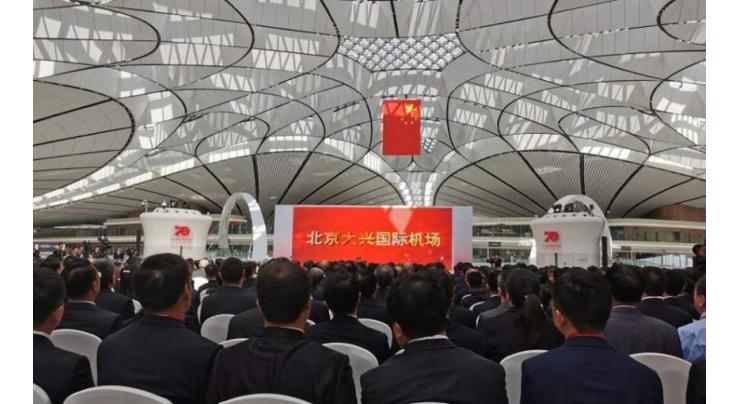
Beijing's New Airport Showcasing 5G Technology
Daniyal Sohail Published September 26, 2019 | 12:38 AM

Beijing Daxing International Airport, opened by Chinese President Xi Jinping Wednesday morning, will become a key node for aviation in northern China and across Asia
The 5G-based smart travel system co-developed by Huawei and China Unicom with base stations installed throughout the sprawling terminal will promise a connection speed of 1.2 Gbit per second, about 100 times faster than the current 4G system, according the South China Morning Post.
5G-enabled services, such as facial recognition for check-in and security, personalised airport experience through the airline's smart app and paperless luggage services, are part of the first wave of new 5G enabled smart air travel services aimed at improving passenger experience at airports.
These services, delivered through the use of 5G, AI and AR, set the standard for the new generation of smart airports. This makes the airport a new model of utilising 5G Gigabit networks in the civil aviation industry. The collaboration with the mobile telecom industry will empower the airport to take its brand to a new height.
The 5G coverage across the airport terminals is achieved with Huawei's digital indoor system 5G LampSite, which was deployed for China Unicom Beijing in August, 2019. The speeds achieved in field tests exceeded 1.2 Gbit/s, showing that the network meets the requirements to provide ultimate 5G experience to passengers.
At Beijing Daxing International Airport, passengers of China Eastern Airlines do not need to show up their ID cards or scan QR codes any more. Thanks to the smart travel service system, passengers can complete all travel transactions from ticket purchase to check-in, luggage consignment, security check, and boarding just by having their faces scanned.
When fully operational starting on October 1, Daxing will feature advanced surveillance technology to ease bottlenecks in security and immigration screening.
Identity verification will be carried out by HD cameras that match the user's face to a national ID database, and comparison and analysis can be done in 0.2 seconds, meaning a passenger does not have to pause to wait for the verification to finish when he passes a security channel, unless a red light flashes warning staff he is not a genuine passenger.
The smart solution can save flyers 30% of their time normally spent waiting in queues, on the strength of the facial image-based access control and big data analytics to reduce the need for manual passenger identification.
The network is also behind the use of radio-frequency identification technology to help passengers track their bags in real-time on their smartphones, after they log flight numbers and destinations on Daxing's official app or that of a specific airline.
On the tarmac, ground lighting and aircraft path planning supported by internet-of-things technology will also expedite the movement of jets for about 1,000 flights a day that will fly in and out of Daxing to reduce the average time from landing to passenger unloading to about 15 minutes, at an airport with four runways.
Daxing airport is expected to become the world's busiest airport, with capacity to handle 45 million passengers by 2021, scaling to 72 million by 2025 and 100 million by 2040. Located south of Beijing, the airport site encompasses 47 square kilometres (18 square miles).
Related Topics
Recent Stories

Tennis: ATP Barcelona Open results - 1st update

Swiatek's perfect 10 in Stuttgart as Vondrousova stuns Sabalenka

Arandu's roads closed due to flooding

Oil tanker catches fire in Islamabad’s Blue Area

Pakistan committed to ensure safety of foreign nationals: FO

Tennis: WTA Stuttgart results - 1st update

Four passengers injured as train hit an empty vehicle

Over- speeding bus crushed to death two bike riders

Turkey's Freedom Flotilla ready to set sail for Gaza

French teen dies from heart failure after knife attack near school

Iranians appear unfazed by Isfahan blasts

UAF celebrates Int'l Chinese Language Day
More Stories From Technology
-

Take Charge, Live Free: Empower Your Life with Infinix NOTE 40 Series
1 day ago -

PTA Undertakes Consultation with All Pakistan Network Association (APNA) on Proposed Class Value Add ..
1 day ago -

Vivo V30 5G: The Perfect Blend of Enhanced Photography and Premium Design
2 days ago -
PITB's Regional Plan 9 invites applications for its newly launched incubation centers in Rawalpindi, ..
4 days ago -

Pakistan calls for enhanced information integrity on digital platforms
4 days ago -

Infinix NOTE 40 Series vs. the Competition: Why It Stands Out
4 days ago
-

"Unlock Exceptional Value: The New realme Note 50 with Extended Warranty Now Available in Pakistan!� ..
5 days ago -

Google unveils new AI chips, arm-based processor for data centers
10 days ago -

Italy considers stricter penalties for AI-related crimes
10 days ago -

Malaysia Calls on Meta and TikTok to Enhance Platform Monitoring
10 days ago -

Always Up-to-Date: Enjoy the Latest Android Updates on Your Infinix NOTE 40 Series for 2 Years
12 days ago -

Vivo V30 5G: Insights from Pakistan's Tech Experts and Lifestyle Influencers
13 days ago










